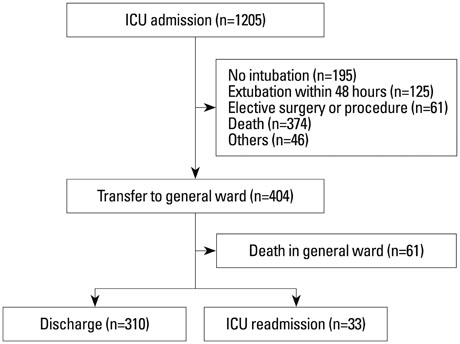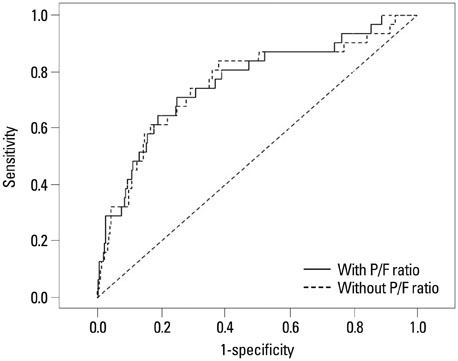Yonsei Med J.
2015 Mar;56(2):543-549. 10.3349/ymj.2015.56.2.543.
Readmission to Medical Intensive Care Units: Risk Factors and Prediction
- Affiliations
-
- 1Division of Pulmonary and Critical Care Medicine, Department of Internal Medicine, Seoul National University College of Medicine, Seoul National University Bundang Hospital, Seongnam, Korea. lungdrcho@gmail.com
- KMID: 2070036
- DOI: http://doi.org/10.3349/ymj.2015.56.2.543
Abstract
- PURPOSE
The objectives of this study were to find factors related to medical intensive care unit (ICU) readmission and to develop a prediction index for determining patients who are likely to be readmitted to medical ICUs.
MATERIALS AND METHODS
We performed a retrospective cohort study of 343 consecutive patients who were admitted to the medical ICU of a single medical center from January 1, 2008 to December 31, 2012. We analyzed a broad range of patients' characteristics on the day of admission, extubation, and discharge from the ICU.
RESULTS
Of the 343 patients discharged from the ICU alive, 33 (9.6%) were readmitted to the ICU unexpectedly. Using logistic regression analysis, the verified factors associated with increased risk of ICU readmission were male sex [odds ratio (OR) 3.17, 95% confidence interval (CI) 1.29-8.48], history of diabetes mellitus (OR 3.03, 95% CI 1.29-7.09), application of continuous renal replacement therapy during ICU stay (OR 2.78, 95% CI 0.85-9.09), white blood cell count on the day of extubation (OR 1.13, 95% CI 1.07-1.21), and heart rate just before ICU discharge (OR 1.03, 95% CI 1.01-1.06). We established a prediction index for ICU readmission using the five verified risk factors (area under the curve, 0.76, 95% CI 0.66-0.86).
CONCLUSION
By using specific risk factors associated with increased readmission to the ICU, a numerical index could be established as an estimation tool to predict the risk of ICU readmission.
Keyword
MeSH Terms
Figure
Cited by 2 articles
-
Risk factors for intensive care unit readmission after lung transplantation: a retrospective cohort study
Hye-Bin Kim, Sungwon Na, Hyo Chae Paik, Hyeji Joo, Jeongmin Kim
Acute Crit Care. 2021;36(2):99-108. doi: 10.4266/acc.2020.01144.Factors associated with unplanned intensive care unit readmission among trauma patients in Republic of Korea
Yongwoong Lee, Byung Hee Kang
Acute Crit Care. 2024;39(4):583-592. doi: 10.4266/acc.2024.00584.
Reference
-
1. Metnitz PG, Fieux F, Jordan B, Lang T, Moreno R, Le Gall JR. Critically ill patients readmitted to intensive care units--lessons to learn? Intensive Care Med. 2003; 29:241–248.
Article2. Renton J, Pilcher DV, Santamaria JD, Stow P, Bailey M, Hart G, et al. Factors associated with increased risk of readmission to intensive care in Australia. Intensive Care Med. 2011; 37:1800–1808.
Article3. Rosenberg AL, Hofer TP, Hayward RA, Strachan C, Watts CM. Who bounces back? Physiologic and other predictors of intensive care unit readmission. Crit Care Med. 2001; 29:511–518.
Article4. Rosenberg AL, Watts C. Patients readmitted to ICUs*: a systematic review of risk factors and outcomes. Chest. 2000; 118:492–502.5. Capuzzo M, Moreno RP, Alvisi R. Admission and discharge of critically ill patients. Curr Opin Crit Care. 2010; 16:499–504.
Article6. Heidegger CP, Treggiari MM, Romand JA. Swiss ICU Network. A nationwide survey of intensive care unit discharge practices. Intensive Care Med. 2005; 31:1676–1682.
Article7. Skowronski GA. Bed rationing and allocation in the intensive care unit. Curr Opin Crit Care. 2001; 7:480–484.
Article8. Kramer AA, Higgins TL, Zimmerman JE. Intensive care unit readmissions in U.S. hospitals: patient characteristics, risk factors, and outcomes. Crit Care Med. 2012; 40:3–10.9. Chrusch CA, Olafson KP, McMillan PM, Roberts DE, Gray PR. High occupancy increases the risk of early death or readmission after transfer from intensive care. Crit Care Med. 2009; 37:2753–2758.
Article10. Gajic O, Malinchoc M, Comfere TB, Harris MR, Achouiti A, Yilmaz M, et al. The Stability and Workload Index for Transfer score predicts unplanned intensive care unit patient readmission: initial development and validation. Crit Care Med. 2008; 36:676–682.
Article11. Campbell AJ, Cook JA, Adey G, Cuthbertson BH. Predicting death and readmission after intensive care discharge. Br J Anaesth. 2008; 100:656–662.
Article12. Fernandez R, Serrano JM, Umaran I, Abizanda R, Carrillo A, Lopez-Pueyo MJ, et al. Ward mortality after ICU discharge: a multicenter validation of the Sabadell score. Intensive Care Med. 2010; 36:1196–1201.
Article13. Reini K, Fredrikson M, Oscarsson A. The prognostic value of the Modified Early Warning Score in critically ill patients: a prospective, observational study. Eur J Anaesthesiol. 2012; 29:152–157.
Article14. Badawi O, Breslow MJ. Readmissions and death after ICU discharge: development and validation of two predictive models. PLoS One. 2012; 7:e48758.
Article15. Fernandez R, Baigorri F, Navarro G, Artigas A. A modified McCabe score for stratification of patients after intensive care unit discharge: the Sabadell score. Crit Care. 2006; 10:R179.16. Ouanes I, Schwebel C, Français A, Bruel C, Philippart F, Vesin A, et al. A model to predict short-term death or readmission after intensive care unit discharge. J Crit Care. 2012; 27:422.
Article17. Hosein FS, Bobrovitz N, Berthelot S, Zygun D, Ghali WA, Stelfox HT. A systematic review of tools for predicting severe adverse events following patient discharge from intensive care units. Crit Care. 2013; 17:R102.
Article18. Frost SA, Alexandrou E, Bogdanovski T, Salamonson Y, Davidson PM, Parr MJ, et al. Severity of illness and risk of readmission to intensive care: a meta-analysis. Resuscitation. 2009; 80:505–510.
Article19. Kaben A, Corrêa F, Reinhart K, Settmacher U, Gummert J, Kalff R, et al. Readmission to a surgical intensive care unit: incidence, outcome and risk factors. Crit Care. 2008; 12:R123.
Article
- Full Text Links
- Actions
-
Cited
- CITED
-
- Close
- Share
- Similar articles
-
- Predictive Factors of Intensive Care Unit Readmission among Older Patients: A Retrospective Study
- Clinical Features and Risk Factors of Patients Readmitted to ICU
- The Risk Factors Related to Early Readmission to the Intensive Care Unit
- Rehabilitation in Intensive Care Unit
- What intensive care unit readmission means




